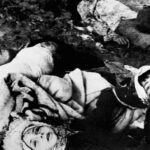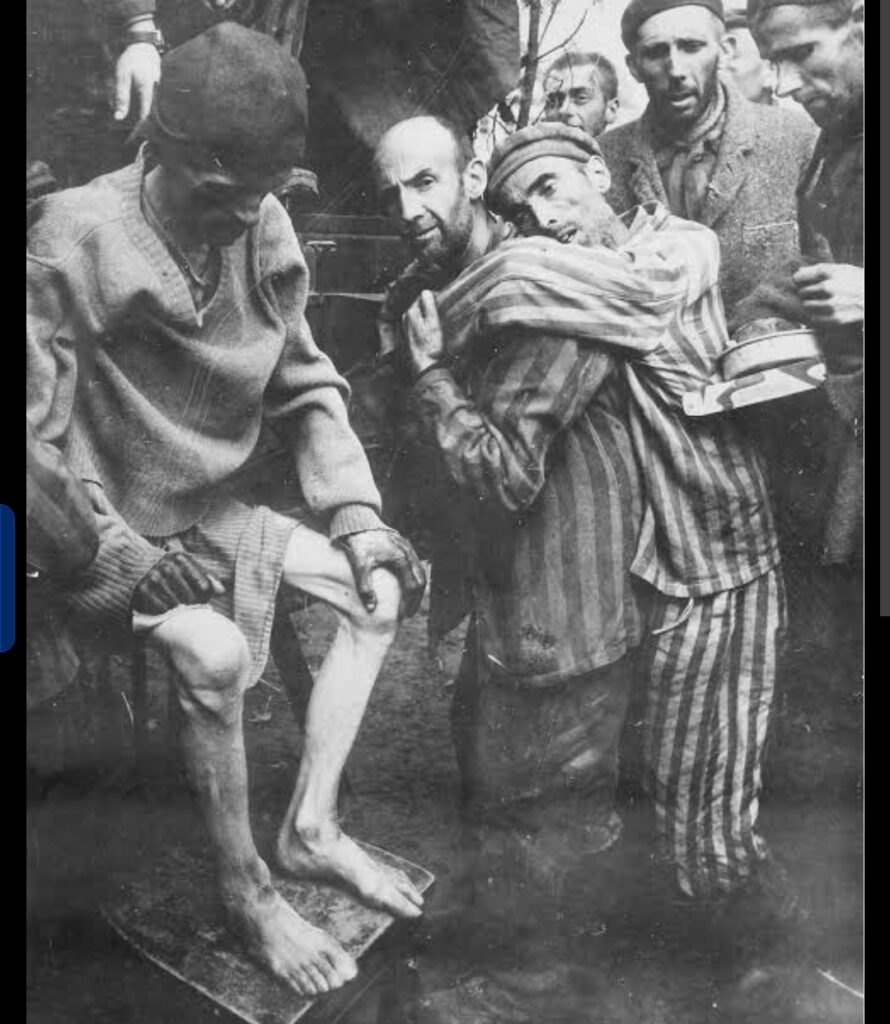The Holocaust A genocide during World War II, where six million Jews and millions of others were systematically murdered by the Nazi regime.

The Holocaust, known in Hebrew as the Shoah, was the genocide of European Jews during World War II. Between 1941 and 1945, Nazi Germany and its collaborators systematically murdered some six million Jews across German-occupied Europe, around two-thirds of Europe’s Jewish population. The murders were carried out primarily through mass shootings and poison gas in extermination camps, chiefly Auschwitz-Birkenau, Treblinka, Belzec, Sobibor, and Chełmno in occupied Poland. Separate Nazi persecutions killed a similar or larger number of non-Jewish civilians and prisoners of war (POWs); the term Holocaust is sometimes used to include the murder and persecution of non-Jewish groups.
The Nazis developed their ideology based on racism and pursuit of “living space”, and seized power in early 1933. Meant to force all German Jews to emigrate, regardless of means, the regime passed anti-Jewish laws, encouraged harassment, and orchestrated a nationwide pogrom in November 1938. After Germany invaded Poland in September 1939, occupation authorities began to establish ghettos to segregate Jews. Following the June 1941 invasion of the Soviet Union, 1.5 to 2 million Jews were shot by German forces and local collaborators. By early 1942, the Nazis decided to murder all Jews in Europe.
Victims were deported to extermination camps where those who had survived the trip were killed with poisonous gas, while others were sent to forced labor camps where many died from starvation, abuse, exhaustion, or being used as test subjects in experiments. Property belonging to murdered Jews was redistributed to the German occupiers and other non-Jews. Although the majority of Holocaust victims died in 1942, the killing continued until the end of the war in May 1945.
Many Jewish survivors emigrated out of Europe after the war. A few Holocaust perpetrators faced criminal trials. Billions of dollars in reparations have been paid, although falling short of the Jews’ losses. The Holocaust has also been commemorated in museums, memorials, and culture. It has become central to Western historical consciousness as a symbol of the ultimate human evil.

Rise of Nazi Germany
Amidst a worldwide economic depression and political fragmentation, the Nazi Party rapidly increased its support, reaching a high of 37 percent in mid-1932 elections, by campaigning on issues such as anticommunism and economic recovery. Hitler was appointed chancellor in January 1933 in a backroom deal supported by right-wing politicians.
Within months, all other political parties were banned, the regime seized control of the media, tens of thousands of political opponents—especially communists—were arrested, and a system of camps for extrajudicial imprisonment was set up. The Nazi regime cracked down on crime and social outsiders—such as Roma and Sinti, homosexual men, and those perceived as workshy—through a variety of measures, including imprisonment in concentration camps. The Nazis forcibly sterilized 400,000 people and subjected others to forced abortions for real or supposed hereditary illnesses.
Although the Nazis sought to control every aspect of public and private life, Nazi repression was directed almost entirely against groups perceived as outside the national community. Most Germans had little to fear provided they did not oppose the new regime. The new regime built popular support through economic growth, which partly occurred through state-led measures such as rearmament. The annexations of Austria (1938), Sudetenland (1938), and Bohemia and Moravia (1939) also increased the Nazis’ popular support. Germans were inundated with propaganda both against Jews and other groups targeted by the Nazis.
Persecution of Jews

Main article: The Holocaust in Germany
Further information: Anti-Jewish legislation in pre-war Nazi Germany
The roughly 500,000 German Jews made up less than 1 percent of the country’s population in 1933. They were wealthier on average than other Germans and largely assimilated, although a minority were recent immigrants from eastern Europe.
Various German government agencies, Nazi Party organizations, and local authorities instituted about 1,500 anti-Jewish laws. In 1933, Jews were banned or restricted from several professions and the civil service. After hounding the German Jews out of public life by the end of 1934, the regime passed the Nuremberg Laws in 1935. The laws reserved full citizenship rights for those of “German or related blood”, restricted Jews’ economic activity, and criminalized new marriages and sexual relationships between Jews and non-Jewish Germans.
Jews were defined as those with three or four Jewish grandparents; many of those with partial Jewish descent were classified as Mischlinge, with varying rights. The regime also sought to segregate Jews with a view to their ultimate disappearance from the country. Jewish students were gradually forced out of the school system. Some municipalities enacted restrictions governing where Jews were allowed to live or conduct business. In 1938 and 1939, Jews were barred from additional occupations, and their businesses were expropriated to force them out of the economy.
Anti-Jewish violence, largely locally organized by members of Nazi Party institutions, took primarily non-lethal forms from 1933 to 1939. Jewish stores, especially in rural areas, were often boycotted or vandalized. As a result of local and popular pressure, many small towns became entirely free of Jews and as many as a third of Jewish businesses may have been forced to close.
Anti-Jewish violence was even worse in areas annexed by Nazi Germany.[65] On 9–10 November 1938, the Nazis organized Kristallnacht (Night of Broken Glass), a nationwide pogrom. Over 7,500 Jewish shops (out of 9,000) were looted, more than 1,000 synagogues were damaged or destroyed, at least 90 Jews were murdered, and as many as 30,000 Jewish men were arrested, although many were released within weeks. German Jews were levied a special tax that raised more than 1 billion Reichsmarks (RM).
The Nazi government wanted to force all Jews to leave Germany. Out of the 560,000 Jews in the country, 130,000 were able to emigrate between 1933 and 1937, most of them towards South Africa, Mandatory Palestine, and South America. Some went back to Eastern Europe. Another 120,000 left Germany in 1938 and 1939. Almost no country lowered the restrictions to immigrate, so obtaining the necessary documents was difficult.
By the end of 1939, most Jews who could emigrate had already done so; those who remained behind were disproportionately elderly, poor, or female. Until 1939 100,000 were in USA; 50,000 each in Palestine, UK, Argentina; 30,000 each in the Netherlands, Belgium, France, South Africa, and Shanghai. Germany collected emigration taxes of nearly 1 billion RM, mostly from Jews. The policy of forced emigration continued into 1940.
Besides Germany, a significant number of other European countries abandoned democracy for some kind of authoritarian or fascist rule. Many countries, including Bulgaria, Hungary, Poland, Romania, and Slovakia, passed antisemitic legislation in the 1930s and 1940s. In October 1938, Germany deported many Polish Jews in response to a Polish law that enabled the revocation of citizenship for Polish Jews living abroad.
Start of World War II
The German Wehrmacht (armed forces) invaded Poland on 1 September 1939, triggering declarations of war from the United Kingdom and France. During the five weeks of fighting, as many as 16,000 civilians, hostages, and prisoners of war may have been shot by the German invaders; there was also a great deal of looting. Special units known as Einsatzgruppen followed the army to eliminate any possible resistance.
Around 50,000 Polish and Polish Jewish leaders and intellectuals were arrested or executed. The Auschwitz concentration camp was established to hold those members of the Polish intelligentsia not killed in the purges.[88] Around 400,000 Poles were expelled from the Wartheland in western Poland to the General Governorate occupation zone from 1939 to 1941, and the area was resettled by ethnic Germans from eastern Europe.
The rest of Poland was occupied by the Soviet Union, which invaded Poland from the east on 17 September pursuant to the German–Soviet pact. The Soviet Union deported hundreds of thousands of Polish citizens to the Soviet interior, including as many as 260,000 Jews who largely survived the war. Although most Jews were not communists, some accepted positions in the Soviet administration, contributing to a pre-existing perception among many non-Jews that Soviet rule was a Jewish conspiracy. In 1940, Germany invaded much of western Europe including the Netherlands, Belgium, Luxembourg, France, and Denmark and Norway. In 1941, Germany invaded Yugoslavia and Greece. Some of these new holdings were fully or partially annexed into Germany while others were placed under civilian or military rule.
The war provided cover for “Aktion T4”, the murder of around 70,000 institutionalized Germans with mental or physical disabilities at specialized killing centers using poison gas. The victims included all 4,000 to 5,000 institutionalized Jews.[96] Despite efforts to maintain secrecy, knowledge of the killings leaked out and Hitler ordered a halt to the centralized killing program in August 1941.
Decentralized killings via denial of medical care, starvation, and poisoning caused an additional 120,000 deaths by the end of the war. Many of the same personnel and technologies were later used for the mass murder of Jews.










Leave a Reply